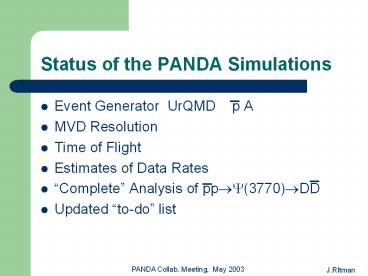Status of the PANDA Simulations - PowerPoint PPT Presentation
1 / 31
Title:
Status of the PANDA Simulations
Description:
Status of the PANDA Simulations. Event Generator UrQMD p A. MVD Resolution. Time of Flight ... PANDA Collab. Meeting, May 2003. Using UrQMD for pA (A.Galoyan) ... – PowerPoint PPT presentation
Number of Views:32
Avg rating:3.0/5.0
Title: Status of the PANDA Simulations
1
Status of the PANDA Simulations
- Event Generator UrQMD p A
- MVD Resolution
- Time of Flight
- Estimates of Data Rates
- Complete Analysis of pp?Y(3770)?DD
- Updated to-do list
2
Using UrQMD for pA (A.Galoyan)
- UrQMD OK but must be modified GaloyanPolanski
hep-ph/0304196 - Multiplicity distribution Produced Particles
- p (7 GeV/c) Fe (10K events)
3
Phase Space Distribution
- All particles Q vs P Neutron dN/dQ
Q
4
MVD Resolution (A.Sokolov)
- Investigate MVD resolution with pp?4mm (8GeV)
- Take small angle scattering into account with a
reduced weight for hits in outer layers - Modify pad orientation
- 1st and 3rd 5th layers with pads ? to beam
- 2nd layer to beam direction
- Pad intrinsic resolution 12x70 mm
- Increase diameter of the the beam pipe
5
Vertex Resolution
- D0 radial distance
- Z0 longitudinal distance
polar angle Q
polar angle Q
polar angle Q
6
Increased Beam Pipe Diameter
7
Z0 Resolution, R40 mm Beam Pipe
sZ0 increases from 13 mm to 18 mm
8
Systematic Error in Z0
9
Momentum Resolution
mean resolution for pp?4m events at 8 GeV
10
Time of Flight (C.Schwarz)
- Kaon ID in the DIRC starts at about 600 MeV/c
- Can Reduce of DIRC PMTs with ToF
- Redundancy
- Fast trigger
- Resolution 100 ps
- Detector type RPC or scintillator?
11
TOP (Time of Propagation)
12
DIRC vs ToF
DIRC is needed for Pgt600 MeV/c and ToF for Plt600
MeV/c
13
Estimated Data Rates (P.SalaburaJR)
- Number of Readout Channels
- Mean Multiplicity
- Data per Event
- Event rate (107 Hz interactions)
14
Number of Readout Channels
- MVD 9.2x106 pixels
- STT 8.7x103 wires
- MDCT 1.7x103 wires
- DIRC 1.0x104 PMTs
- EMCT 7.5x103 crystals
- RICH 4.5x104 pads
- MuonT 3.2x104 cells
- ToFFS
15
(No Transcript)
16
(No Transcript)
17
Mean Multiplicities (pp 8 GeV/c)
- MVD 12 hits/evt x 2.5 pads/hit 30
- STT 94
- MDCT 37
- DIRC 7 bars/evt x 20 PMTs/hit x ½ 70
- EMCT 82
- RICH 1 hit/evt x 15 pads/hit 15
- MuonT 0.26
- ToFFS ???
18
Number of bits per Hit (rounded)
- MVD Layer(4)Coordinate(2x10)sysID(8) 32
- STT Layer(4)Wire(10)Time(2x10)sysID(8) 48
- MDCT Layer(4)Wire(8)Time(10)sysID(8) 32
- DIRC PMT(14)E(12)T(12)sysID(8) 48
- EMCT Crystal(13)E(15)sysID(8) 48
- RICH PadNumber(2x8)sysID(8) 24
- MuonT Cell(12)T(12) sysID(8) 32
- ToFFS
19
Total Data Rates (107 Hz)
- Detector bits/hit Multiplicity Total
(GBytes/sec) - MVD 32 30 1.2
- STT 48 94 5.6
- MDCT 32 37 1.5
- DIRC 48 70 4.2
- EMCT 48 82 5
- RICH 24 15 0.5
- MuonT 32 0.25 0.01
- ToFFS ?7?
- 25 GB/s
20
Analysis of pp?Y(3770)?DD (JR)
- Single D?Kpp Selector (BR9.1)
- pp?Y(3770)?DD
- Background Estimates
- report at GSI Docuserver
- http//www-new.gsi.de/onTEAM/tree/temp/1053448016/
191053014637.ps
21
Vertex Resolution (1 D per event)
Force the decay at V(0.1,0.1,0.4) mm
PD3.3GeV/c Combine - - or - tracks (i.e. no
PID) for reconstruction M1865 sM7.3
MeV/c2 e 0.71
sZ22 mm
VR mm
VZ mm
22
Y(3770) ? DD ? KK-2p2p-
10,000 Events
M-- GeV
23
Decay Vertex Location
Transverse
Longitudinal
D mm
Z mm
Only longitudinal coordinate sensitive to
D-mesons !
24
Proper Lifetime Determination
N(x) exp - V M / (P ct)
ct 292 3 mm input 317 mm
VM/P
25
DD Kinematical Variables
Missing Mass Squared Invariant Mass
(Mmiss)2 GeV2
Minv GeV
N.B. (Mp)2 0.02 GeV2 e 31 (no
PID)
26
Fake D-Candidates from Background
80,000 Events
Vertex Z - Location
- - Inv. Mass
Vz mm
Minv GeV/c2
27
Background Suppression Factors
80,000 input background events 6.6 GeV/c 3,144
D-Candidates (no PID!) 196 events with Vz
gt 0.1 mm 100 events with c2/dof lt 10
(vertex fit) 0 events with a D D-
candidate estimate of remaining cuts by widening
cuts above 1/16000 for the second D
candidate 1/50 (Mmiss)2 lt 0.002 GeV2 1/10 Minv
?s
28
Peak to Background Ratio
Assume a Y(3770) formation cross section of 160
nb
L1032 ? 140 Counts/hour
(still without PID!!!)
29
Summary
- Event Generator UrQMD p A
- MVD Resolution
- Time of Flight
- Estimates of Data Rates
- Complete Analysis of pp?Y(3770)?DD
30
Outlook (Feb 2003 Meeting)
Status May 2003
- pbar-A background generator
- Generation of 107 pbar-p background events
- Introduction of the absolute time, (in
progress) to allow studies of pileup - Add more dead areas/materials
- Detailed studies of thresholds, etc.
- Layer of ToF between DIRC and EMC
- CsI at backward angles?
- Can ee- be selected/triggered (conversion in
MVD) - Improvement of the FastSim
- Evaluation of signal/background ratio
- Input for Trigger/DAQ
- Hypernucleus experiments
31
Outlook 2
group meeting Wed. 11-13
- Target (start detector?)
- Tof
- FS
- 3D Fieldmap
- Tracking (Kalman)
- Kinematic fitters
- Trigger simulations
- Physics Analysis for specific channels(e.g.
Glueballs, DD, leptons, ff, gg, gg)































